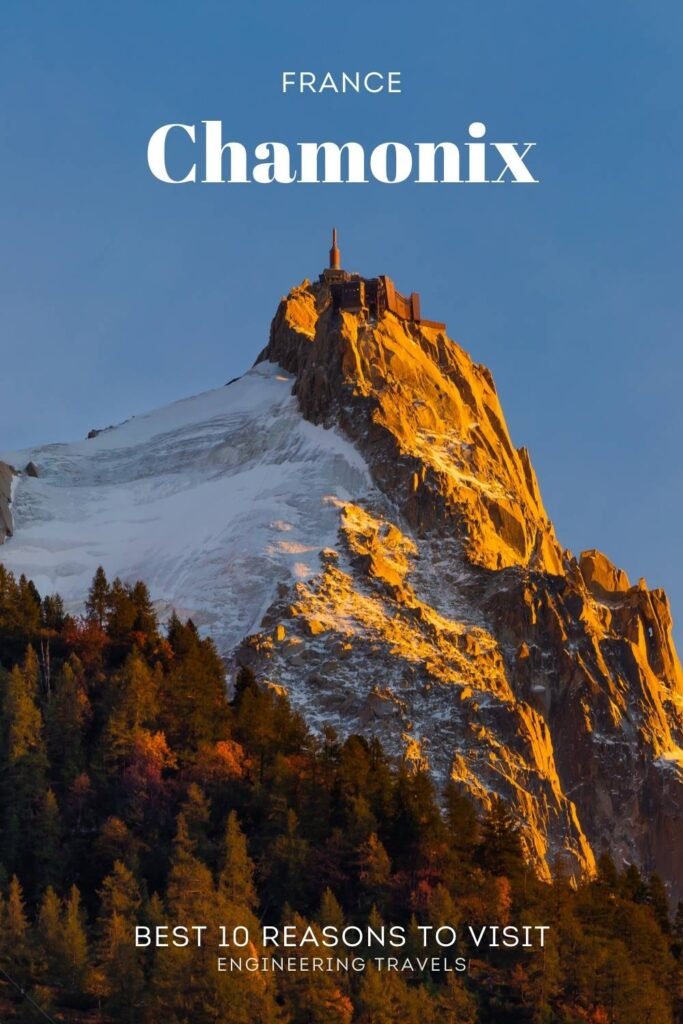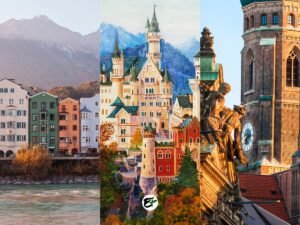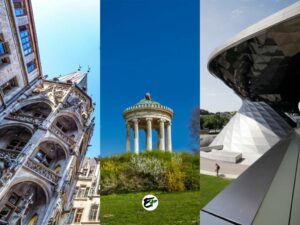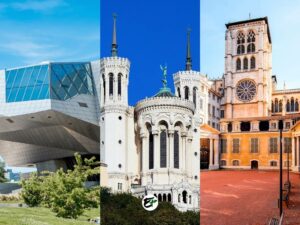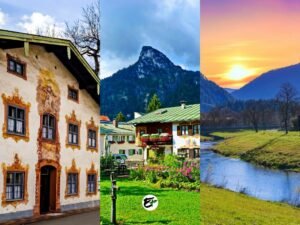10 Best Reasons to Visit Chamonix: An In-Depth Travel Guide
Whenever the “South of France” or southern France is brought up, I can’t help but picture the old cities with their lovely beaches that are often visited by people living lavish lifestyles. However, if you venture into the southeastern part, specifically the Auvergne-Rhône-Alpes region, you’ll discover a breathtaking landscape that’s quite unlike any other in southern France: the Alps.
Nestled in this region is Chamonix, a village that stands out as one of France’s most picturesque. Chamonix, renowned for its outdoor activities and mountain escapades, offers a breathtaking alpine view that makes it one of the most exciting destinations in France.
From the instant Chamonix came into my view, it felt like love at first sight! After taking the time to explore the village and its surrounding mountains, I was deeply convinced that it is a destination not to be missed. Chamonix is a worth visiting for its fantastic outdoor activities and remarkable natural landmarks. The immense Mer de Glace glacier, the scenic Lac Blanc, and the exciting attractions at Aiguille du Midi are just a few of the reasons why Chamonix is such an amazing destination.
And there’s more! In this post, I’ll reveal everything that positions Chamonix as a destination you can’t miss, not just in France but perhaps throughout Europe!
This post contains affiliate links. I may receive a tiny commission at no additional cost to you.

Use the table of contents to skip to topics.
Good to know: This post also includes the best things to do in Chamonix, optimal spots for photography, attractions you must add to your bucket list, useful advice, maps, and links to official websites and credible sources. All these resources aim to assist you in planning a memorable trip to Chamonix if you opt to visit.
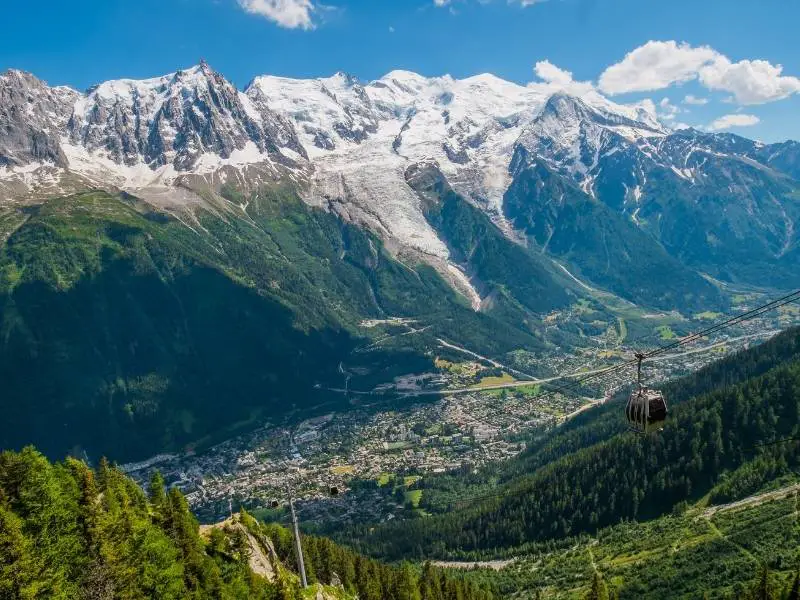
Let’s kick off the list of reasons to visit Chamonix with the wanderer’s favorite.
1. Chamonix’s Quaint and Scenic Villages — Wanderer’s Favorite!
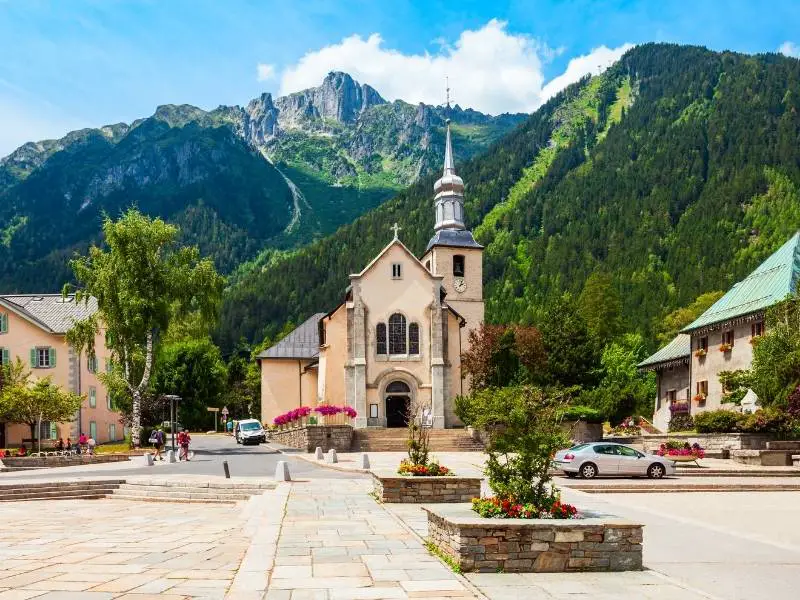
Chamonix is a must-visit destination primarily for its stunning natural surroundings. Nestled in the Chamonix-Mont-Blanc Valley, this charming village is enveloped by breathtaking alpine landscapes, offering panoramic views of majestic mountains at every turn.
And if you’ve never had the pleasure of seeing authentic chalets, a trip to Chamonix is the perfect opportunity! These charming alpine homes are typically constructed from wood and frequently adorned with vibrant flowers on their balconies. Come springtime, you’ll also see these beautiful floral arrangements adorning the streets and river railings.

Visitors who love taking photos can create hundreds of new ones just by wandering around the village. Needless to say, the snow-capped mountains in the backdrop of Chamonix’s buildings are another factor that makes the town look so magical—it’s irresistible not to take pictures.
But, did you know that Chamonix isn’t the only village in the valley? There are four more villages, and they all look undeniably charming and scenic!

These villages in the Chamonix valley are Servoz, Les Houches, Argentiere, and Vallorcine (from southwest to northeast). Chamonix is in the middle of the valley, situated between Les Houches and Argentiere. We’ll discuss more about them as we go along.
If you’re from Lyon, Annecy, or Geneva, the village in the valley you’ll reach first is Servos. If you’re from Italy (Milan), you’ll go straight to Chamonix. Then, from other parts of Switzerland, it’s Vallorcine.
Important: If you’re in the process of planning your trip and have a keen interest in exploring mountains with charming villages, ensure you consider other destinations in the Alps. There’s a plethora to choose from. Northern Italy boasts Lake Garda and Cortina d’Ampezzo, nestled in the heart of the Dolomites. Southern Germany is home to the Bavarian Alps, where towns and villages like Garmisch-Partenkirchen, Mittenwald, and Berchtesgaden, adorned with mural-painted houses, can be found. As for Switzerland, it’s hard to know where to start! From Swiss picturesque villages to cities near the Swiss Alps, there’s a lot to cover. However, my top recommendations would be Zermatt and the villages in the Jungfrau Region such as Lauterbrunnen, Grindelwald, and Interlaken.
First Village: Chamonix Mont-Blanc
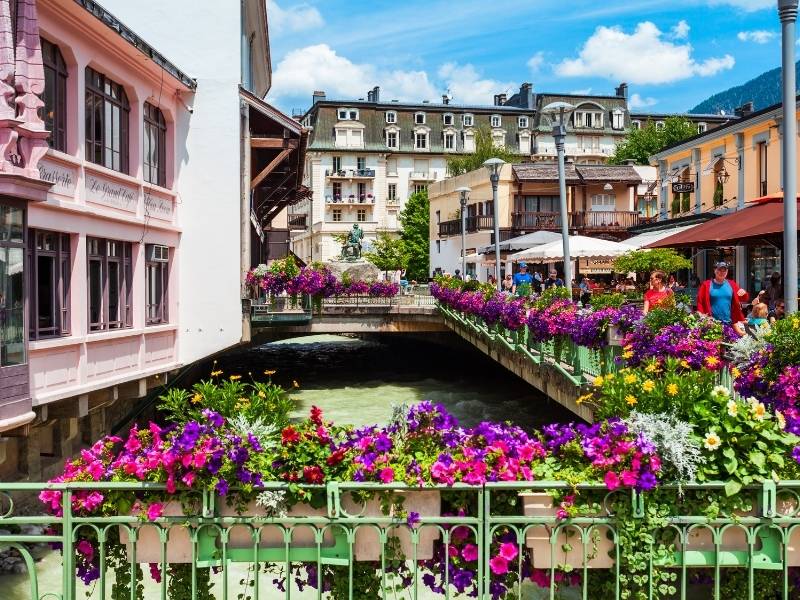
Chamonix is the most famous village in the Chamonix-Mont-Blanc Valley as it’s also the largest and has the most attractions. If you choose downtown Chamonix as your base, accessing or visiting the 9 tourist attractions in the Chamonix valley will be simple.
swipe the 360° image below to see more views
Aside from the lovely chalets, some of the little gems you can find in Chamonix village are the frescoes in the pedestrian center. They depict the 250 years of Chamonix history and Chamonix’s most prominent mountaineering pioneers.
If you have an interest in history, consider visiting the Alpine Museum near Place Saussure, the square with the statues of Saussure commemorating the first ascent of Mont Blanc. The Alpine Museum houses the history of Chamonix, along with information about the valley’s geology and artistic heritage.
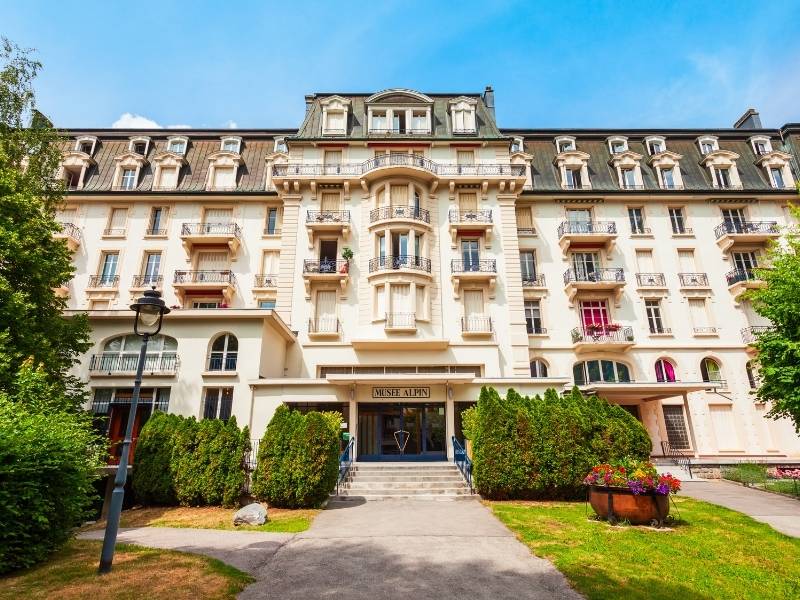
Here are more attractions or activities that are near and can be directly accessed from the Chamonix village:
- Brevent Cable Car — lets you see a stunning panorama of the Mont Blanc Massif (via Telecabine de Planpraz station).
- Aiguille du Midi (valley station) — a mountain in the Mont Blanc massif rising 3,842 meters (12600 feet) above sea level. It is served with one of the highest cable cars in the world!
- Montenvers — the viewing point of the spectacular Mer de Glace (glacier).
For many travelers, a visit to Chamonix village and its surrounding attractions will be more than satisfactory. But if you’re the type who enjoys slow travel and discovering lesser-known spots in the Chamonix valley, then exploring other villages is definitely worth considering.
Second Village: Servoz Mont-Blanc
The other villages nestled in the Chamonix Valley present a more idyllic view. For instance, Servoz will certainly meet your expectations for a quintessential mountain country ambiance.
swipe the 360° image below to see more views
Servoz offers a unique opportunity to experience the local heritage nestled in the Alps. You’ll find alpine farms, traditional bread ovens, fountains that have stood for centuries, and delightful chalets decorated with flowers.
And most importantly, the village has the Maison du Lieutenant Museum which is a must-visit for those interested in local heritage. It’s just a 30-minute hike from Servoz station. On your way there, don’t miss the entrance to Diosaz Gorge; it’s a stunning canyon with five successive waterfalls.
The Maison du Lieutenant Museum, a historical landmark in Servoz village, houses a variety of exhibits showcasing alpine agriculture. This includes displays of animals, plants, mountain pastures, and the equipment used in their care.
It’s worth noting that Servoz village is recognized as the “Arts and Craft Village” of the Chamonix Valley. Many locals are skilled craftsmen and artists who are eager to share their heritage and talents with visitors. As such, you’ll find numerous workshops throughout the village, with the Maison du Lieutenant Museum being one such location.
Third Village: Les Houches Mont-Blanc
Nestled between Servoz and Chamonix is the quaint village of Les Houches. This settlement has the shortest direct distance to Mont-Blanc among all villages in the Chamonix valley. Whether you’re seeking a moment of quiet contemplation or a chance to unwind, Les Houches provides the perfect setting.
swipe the 360° image below to see more views
In Servoz, like in Les Houches, you will also find several alpine pastures. The serene views of the snow-capped Mont-Blanc mountain range, coupled with the chirping of birds in Les Houches, will undoubtedly soothe you to your core.
From Les Houches, you can easily reach three key attractions in the Chamonix valley: Merlet Animal Park, Chavants Leisure Area, and the Prarion Cable Car.
Les Houches also houses the Mountain Museum — a reconstruction of a traditional homestead situated in a mid-18th century farmhouse. Inside, exhibits depict the items, tools, equipment, and other objects that the people of the Chamonix valley used in the past.
Fourth Village: Argentiere Mont-Blanc
North of the village of Chamonix lies the village of Argentiere. The Chamonix tourism office promotes it as a place for visitors to see stunning examples of the region’s traditional architecture.
swipe the 360° image below to see more views
While exploring Argentiere, you can find unique chalets constructed with materials from the mountains, although they are not numerous.
For example, if you go to the northern portion of Argentiere and walk along Chemin de la Moraine, you will find a house that is half made of wood and half made of colorful stone bricks. It’s quite fascinating to see that even the fences along the street are made of thin mountain rocks.
Chemin de la Moraine is very easy to find. Simply head to Eglise d’Argentiere, a 5-minute walk north of Argentiere station, and then proceed east. Eglise d’Argentiere is an 18th-century church built in baroque style. Before you arrive at Eglise d’Argentiere, you will find an Instagrammable arch stone bridge that allows you to cross the Arve River.
However, the main attraction in Argentiere is the glacier tucked in the mountains east of the village. The glacier is named after the town (Argentiere Glacier). You can reach its viewing point at Grands Montets from the Grands Montets Gondola valley station.
Fifth Village: Vallorcine Mont-Blanc
Chamonix boasts hundreds of hiking trails. However, for those seeking quieter paths, Vallorcine is an excellent choice. It offers extensive tranquil trails where one can reflect and fully immerse oneself in nature.
swipe the 360° image below to see more views
Vallorcine, the northernmost village in the Chamonix Valley, is just a few kilometers away from Switzerland. Here, over 80 kilometers of scenic tracks await, perfect for a relaxing stroll in the mountains.
The hiking trails starting from Vallorcine will lead you to hidden gems near the French-Swiss border, such as the Trè-Les-Eaux valley, Bérard valley, and Cornes de Loriaz. From Refuge de Loriaz, you should be able to enjoy a unique view of the Chamonix valley that extends to Argentiere, with the Mont-Blanc Massif in the backdrop.
2. The Mountains Around Chamonix — The Stunning Spectacular Scenery.
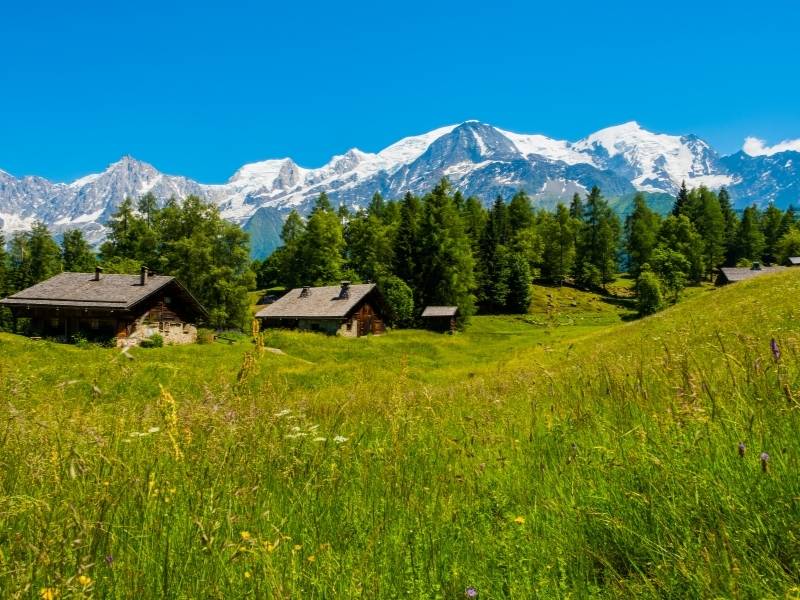
We’ve previously explored the charming villages in the Chamonix valley. While these villages are undoubtedly delightful, the true highlight of Chamonix lies in its majestic mountains, particularly Mont Blanc—the highest peak in the Alps.
Towering above the Chamonix valley, it goes without saying that Mont Blanc is a compelling reason to visit Chamonix. Mont Blanc is the second highest peak in all of Europe, reaching a dizzying height of 4,807 meters (15,774 feet) above sea level. Seeing or standing at one of the highest places in the world is a bucket list item for many.
If you’ve yet to experience that top-of-the-world feeling, a trip to Chamonix will certainly provide it. Despite the chilling winds, the sensation is blissful. From up there, you’ll gain a new appreciation for the majesty of nature: the ethereal sea of clouds, rugged peaks, and layers of mountains fading into shades of blue.
The views from the mountaintops are truly incredible. However, reaching the summit of Mont Blanc is no easy feat and requires hours of hiking. Despite this, you can get very close to Mont Blanc’s summit in just minutes using a cable car. The cable car station is conveniently located in the heart of Chamonix village and can take you to the top of the Mont Blanc massif in about 20 minutes.
The cable car journey ends at a peak called Aiguille du Midi, which stands 3,842 meters above sea level. On a sunny day at Aiguille du Midi, you’ll see more than just the summit of Mont Blanc. The panorama includes sweeping views of the French, Swiss and Italian Alps.
Aiguille du Midi is the primary mountaintop destination in Chamonix and attracts nearly half a million visitors each year! It’s also where most mountaineers begin their ascent to Mont Blanc’s summit. The climb from Aiguille du Midi to Mont Blanc typically takes one to two days to complete.
I wouldn’t recommend attempting to climb Mont Blanc unless you possess technical skills and a high level of physical fitness.
Here are some photos to show you how beautiful Mont Blanc and the mountains are in Chamonix. Have a look:

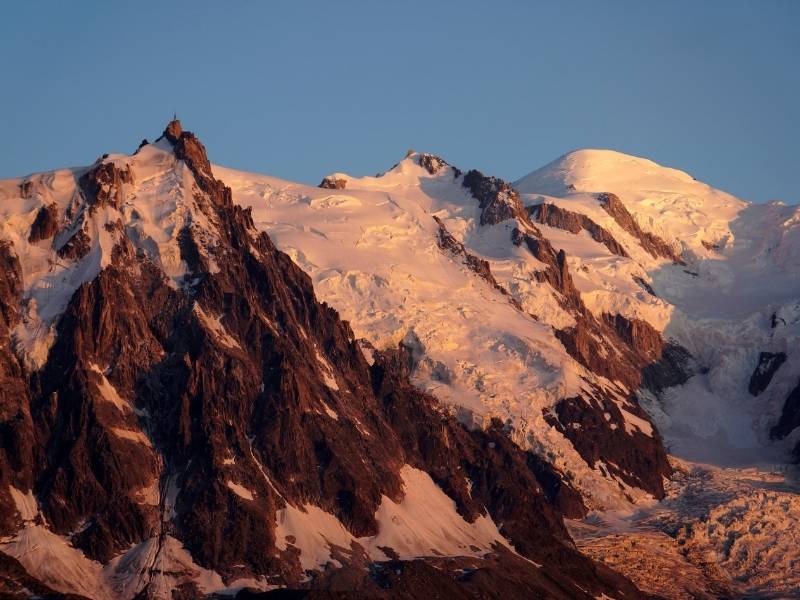
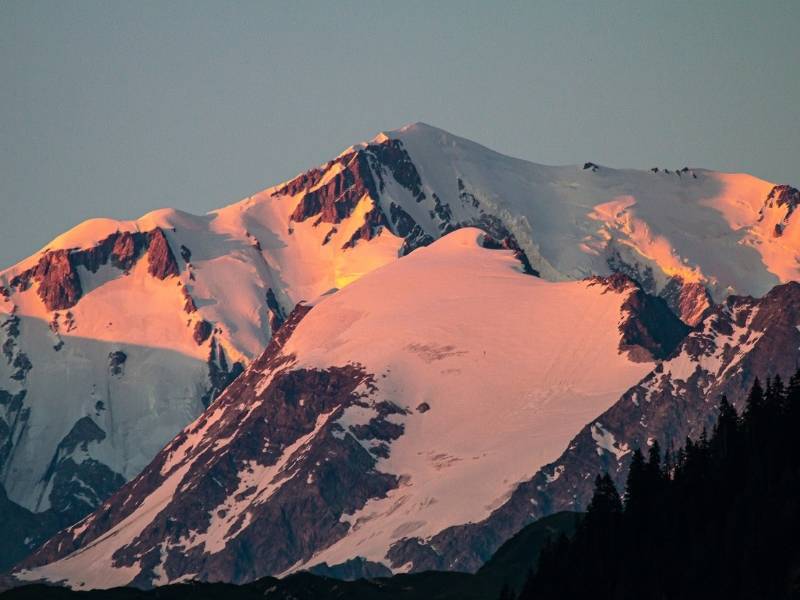
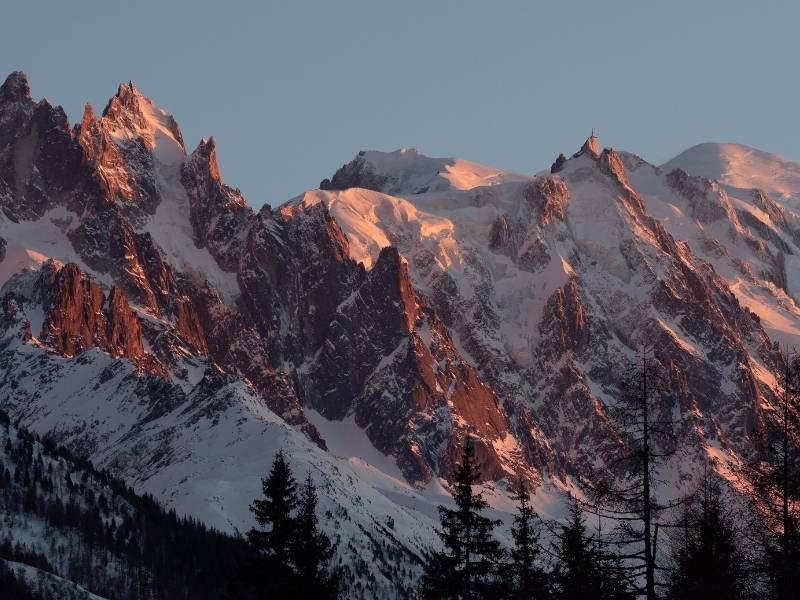
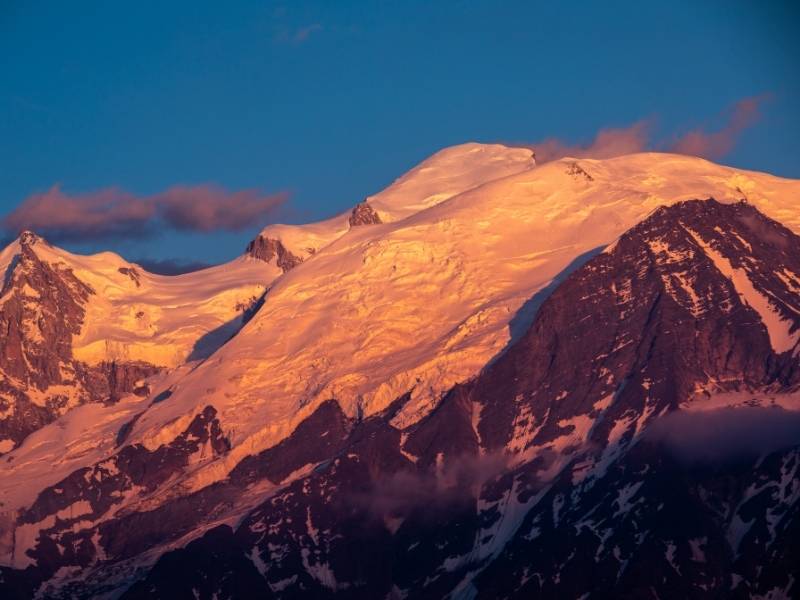
The journey to the top of the Mont Blanc massif doesn’t end at Aiguille du Midi. You can venture further to Pointe Helbronner in Italy, on the other side of Mont Blanc.
Aiguille du Midi and Pointe Helbronner are connected by the Panoramic Mont Blanc Cable Car. This 5-kilometer journey in the sky crosses the French-Italian border, offering different perspectives of Mont Blanc and the rest of the Alps.
Don’t worry about returning to Chamonix after crossing into Italy. For your convenience, you can purchase a round-trip ticket for the Panoramic Mont Blanc Cable Car. Aiguille du Midi is usually open all year round, except for scheduled maintenance dates in November. The opening hours vary by season, and access is subject to favorable weather conditions.
For more information, please see the official website of Aiguille du Midi.
3. The Picturesque Lakes Above Chamonix — Otherworldly Views!

The mountains in Chamonix are undeniably stunning. However, if you’re seeking a truly awe-inspiring experience, consider visiting at least one of the lakes nestled within these mountains. Why, you ask?
Alpine lakes are among the most breathtaking natural sights to behold. In my opinion, they alone are a compelling reason to visit Chamonix. Alpine lakes are exceptional and extremely beautiful.
Unlike ordinary lakes, alpine lakes tend to be more pristine and clearer, sometimes even turquoise, and are surrounded by lovely flora and fauna. This is thanks to the mineral-rich glacial waters that feed them! If you’re looking for a place to relax in tranquility, spend time practicing photography, or simply be awestruck by nature’s beauty, the alpine lakes won’t disappoint you.
In the absence of strong winds, typically during September according to the weather summary in Chamonix, these alpine lakes can take on an otherworldly appearance. They become incredibly calm and reflective, acting like giant mirrors!
What’s even more fascinating is that, when viewed from a certain angle, you can see the mountain peaks reflected and inverted on the surface of the lakes. This is a scene that you, and indeed any photographer, won’t want to miss!
Are you interested in knowing the locations of these beautiful lakes in Chamonix? Well, there are many lakes you can visit in Chamonix. In fact, you can even find a few in the villages! However, when it comes to appearance, they are no match for the high-elevation lakes.
If you’re seeking unparalleled alpine beauty, consider visiting the lakes in the Aiguilles Rouges mountain range. This range is situated opposite the Mont Blanc massif, across the Chamonix valley.
From Chamonix village, you’ll see this group of mountains when you look to the northwest. You’ll notice that it’s lower than the Mont Blanc Massif. Due to the position and elevation of the lakes in the Aiguilles Rouges range, travelers visiting these alpine lakes can see the peaks of the Mont Blanc Massif reflected on their surface.
Among all the beautiful lakes in Chamonix, the two you should not miss are Lac Blanc and Lacs des Chéserys, which are located in the Aiguilles Rouges range. Unfortunately, at present, they can only be accessed by hiking.


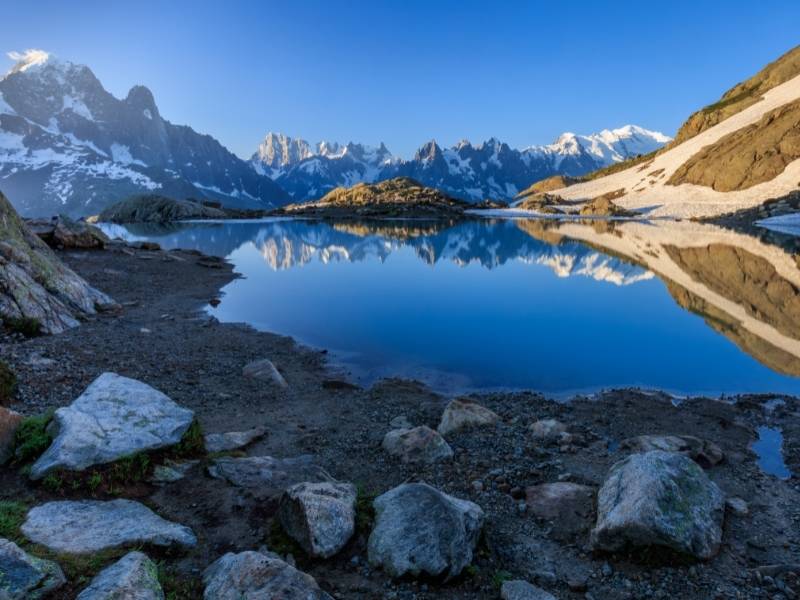
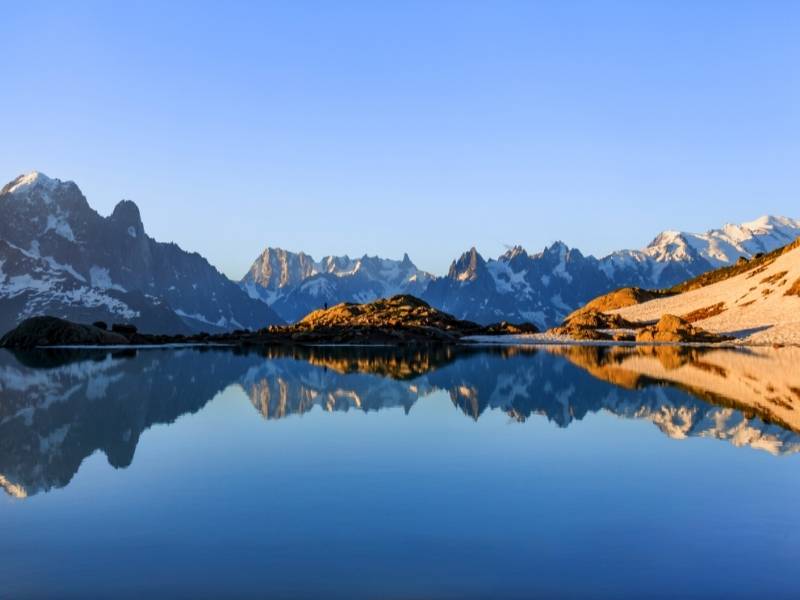
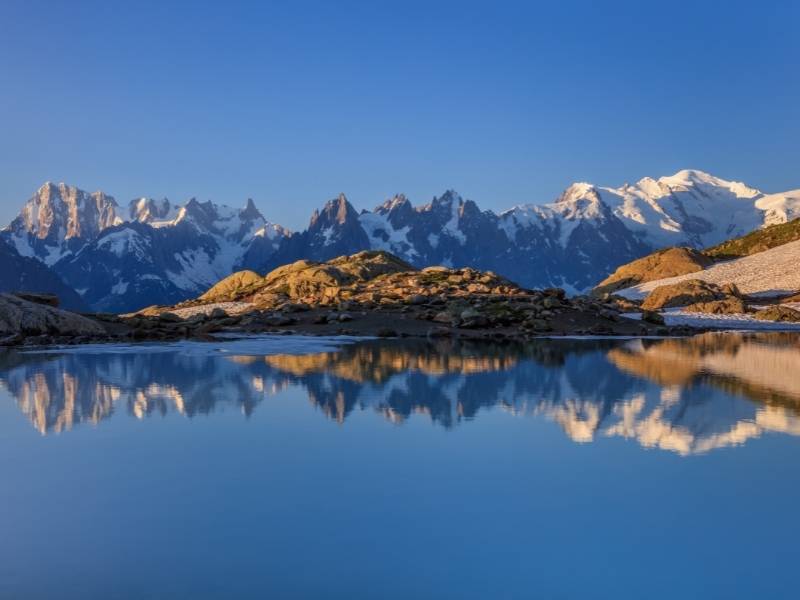
Among the two, the more famous lake is Lac Blanc, named after Mont Blanc. Situated at an elevation of 2352 meters (7716 feet), Lac Blanc offers a breathtaking view of Mont Blanc, complete with its reflection on the lake’s surface.
Not too far from Lac Blanc are the Lacs des Chéserys, a group of small lakes that offer a panorama similar to that seen from Lac Blanc. However, Lacs des Chéserys are slightly lower than Lac Blanc, at an elevation of 1,998 meters (6555 feet). If the wind is calm and the lake’s surface is still, you should be able to see more parts of Mont Blanc reflected on its surface.
Lac Blanc and Lacs des Chéserys can be reached via several hiking trails and can be visited in one hiking trip. You have the option to start from either Argentiere or Chamonix.
However, if you prefer less demanding trails, I recommend starting from Chamonix and taking a cable car ride to Flégère. From the Flégère station, you can make a round trip to visit both lakes in approximately 4 hours.
Please note that this 4-hour estimate is ideal and does not account for pauses during the hike. Considering the time needed for quick rests, meals, taking pictures, admiring the views, and waiting for clouds to clear, a more realistic duration for the trip would be 5 to 6 hours.
Here’s a map you can use as a reference if you want to visit Lac Blanc and Lacs des Chéserys:
Suppose you want to witness the ultimately awe-inspiring sunset and sunrise in Lac Blanc. In that case, you may utilize the refuge near Lac Blanc for an overnight stay. Here’s the website of Lac Blanc Refuge if you want to book your stay. Lastly, remember that these alpine lakes freeze during winter and may stay frozen until the summer months. So, visit only during summer! 🙂
Should you wish to take in the stunning sunset and sunrise at Lac Blanc, you might want to consider spending the night at the refuge close by. Reservations can be made on the Lac Blanc Refuge website. Do bear in mind that these alpine lakes are frozen in winter and can remain so until summer, so summer visits are recommended!
4. Gigantic Glaciers in Chamonix — A Unique Sight & Experience.
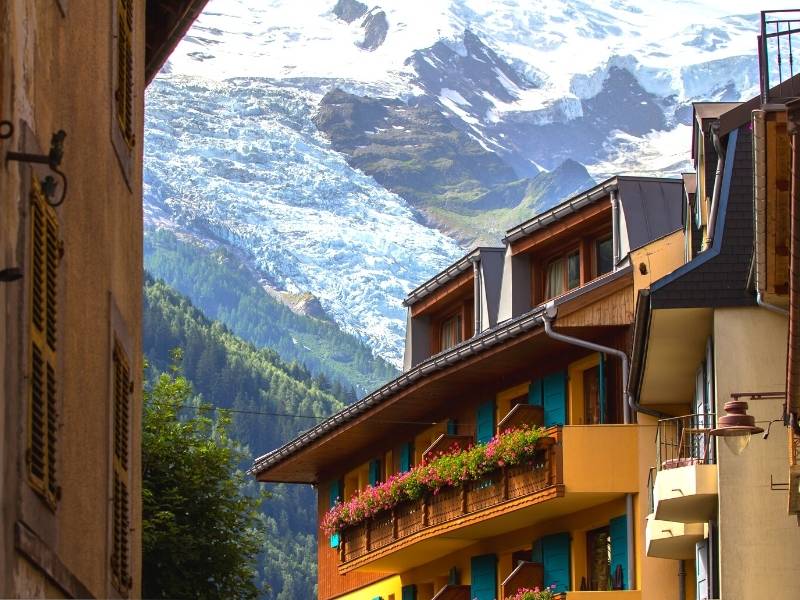
In addition to alpine lakes, glaciers are another natural wonder found in the mountains surrounding Chamonix. They are a compelling reason to visit Chamonix, or the Alps in general, due to their remarkable and rare nature.
Believe it or not, you can actually venture inside a glacier in Chamonix! This place is known as the Ice Cave and offers one of the most unique and thrilling experiences you shouldn’t miss.
Given the rising global temperatures, there’s a certain urgency to witness a glacier. While glaciers won’t disappear instantly, they are thawing at a faster rate than before. Who knows, maybe in five or ten years from now, we won’t be allowed to enter the Ice Cave due to potential collapse hazards. This is just speculation, of course.
Chamonix is home to several glaciers, most of which are located in the Mont Blanc massif. The lower temperatures at these high elevations have allowed the glaciers to persist.
Among the glaciers in Chamonix, the largest ones are the Argentière Glacier, Bossons Glacier, Mer de Glace, and Géant Glacier. The most famous of these, and one you should not miss when visiting Chamonix, is the Mer de Glace, also known as the “Sea of Ice.”


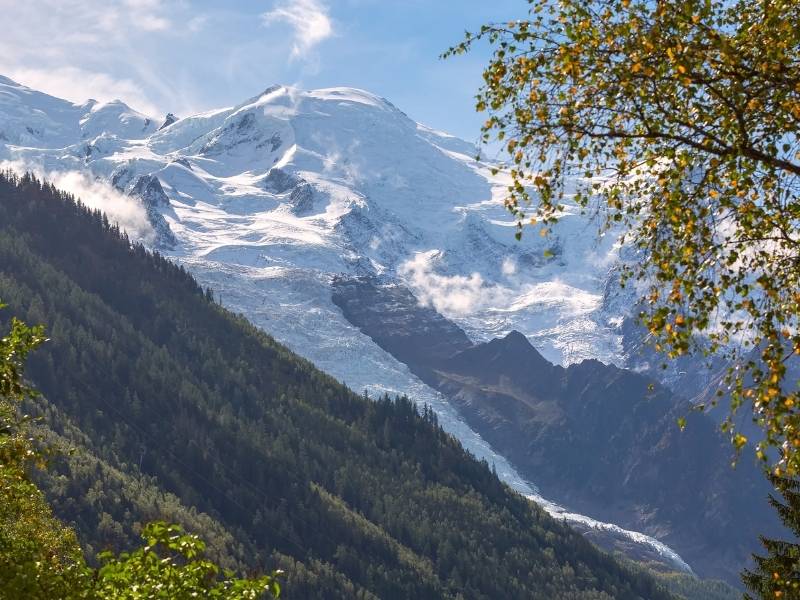
Spanning more than 7 kilometers (4.7 miles) and reaching depths of 200 meters (660 feet), Mer de Glace is recognized as the longest glacier in France. It’s the second longest in the Alps, surpassed only by the Aletsch glacier visible from Lauterbrunnen, Switzerland.
One way to view Mer de Glace is from its renowned viewing deck situated on one of the ridges of Aiguilles de Chamonix, which forms part of the rocky Mont Blanc massif. The Montenvers funicular railway, with a station in Chamonix village, provides access to Mer de Glace’s panoramic deck.
From this vantage point, you’ll have an overlooking view of the glacier as well as the sharp and pointed peaks that reach heights of 3000 to 4000 meters (13123 feet). These peaks present a truly spectacular sight, especially during the golden hours.

These peaks are also Chamonix’s superstar mountains alongside Mont Blanc. Namely, Les Grands Jorasses, Les Drus, and Aiguille du Grépon.
From the station, which also serves as the viewing deck, you’ll find a cable car that descends onto Mer de Glace. This cable car will transport you to the entrance of the Ice Cave, a tunnel carved into the glacier. The Ice Cave is truly otherworldly with its intense blue hues! Inside, you can marvel at the ice sculptures and crystals from the Mont Blanc massif.
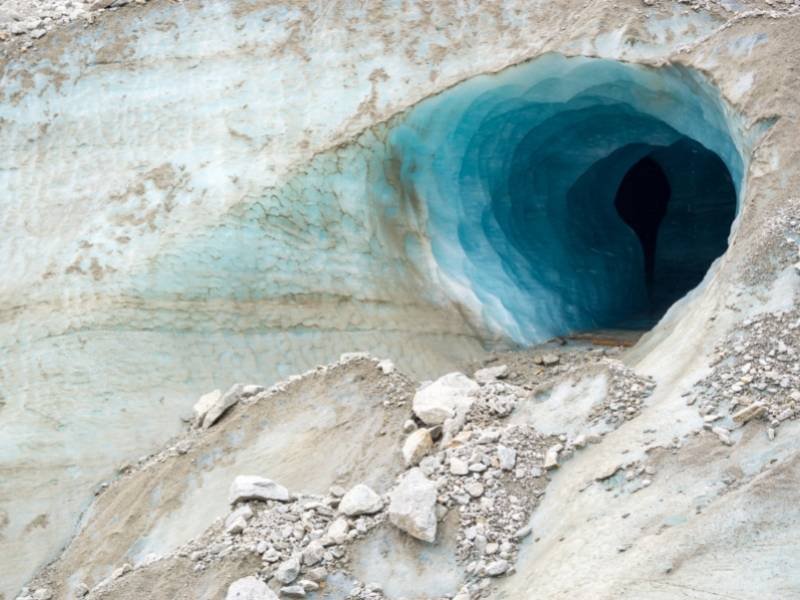



For those with a keen interest in learning more about glaciers, the “Glaciorium” is a must-visit. It features educational videos and exhibits about glaciers, the effects of climate on glaciers, and much more. I recommend visiting this museum first to enhance your understanding and enjoyment of the Ice Cave.
5. Chamonix’s Once-in-a-Lifetime Adventures: The Ones You Won’t Forget

Chamonix is quite literally surrounded by breathtaking natural attractions. The mountains, lakes, and glaciers are all awe-inspiring. A day or two simply isn’t enough to take in everything!
While sightseeing or relaxing on the balcony of your chalet can be rewarding in itself, it’s the adventures that will truly make your trip unforgettable. Why is that? Because adventures are fun, they help you conquer your fears, and they allow you to live life to the fullest!
In Chamonix, you’ll find a plethora of adventurous activities that provide opportunities for an incredible trip. It’s a trip that you can share with all your friends and one that you’ll remember for the rest of your life. So go ahead and live life to the fullest!
According to the official Chamonix tourism website, you can partake in activities such as hiking, trail running, mountain biking, white water sports, paragliding, panoramic flights, and many more. You’re also welcome to bring your dog, your little partner, on your adventure hikes in Chamonix! The range of adventures and activities in Chamonix is so extensive that I believe there’s something for everyone.
However, if there’s one adventure that should be on everyone’s bucket list, it’s panoramic flights or paragliding.
Paragliding may be a bit pricey, but the experience it offers is truly immense! Imagine feeling the thrill, awe, and refreshing wind all at once while enjoying a bird’s eye view of Mont Blanc and its vast glaciers.
There’s no need to worry about piloting, as you’ll be accompanied by an experienced paragliding tandem partner who will take care of everything. Your only job is to enjoy the breathtaking views while humming “I’m like a bird” by Nelly Furtado. Any fear of heights you may have will undoubtedly be replaced by thoughts of “I want to do it all again” after the flight.
You can learn more about tandem paragliding in Chamonix here.
6. The Alpine Wildlife in Chamonix — Graceful, Cute, and Rare
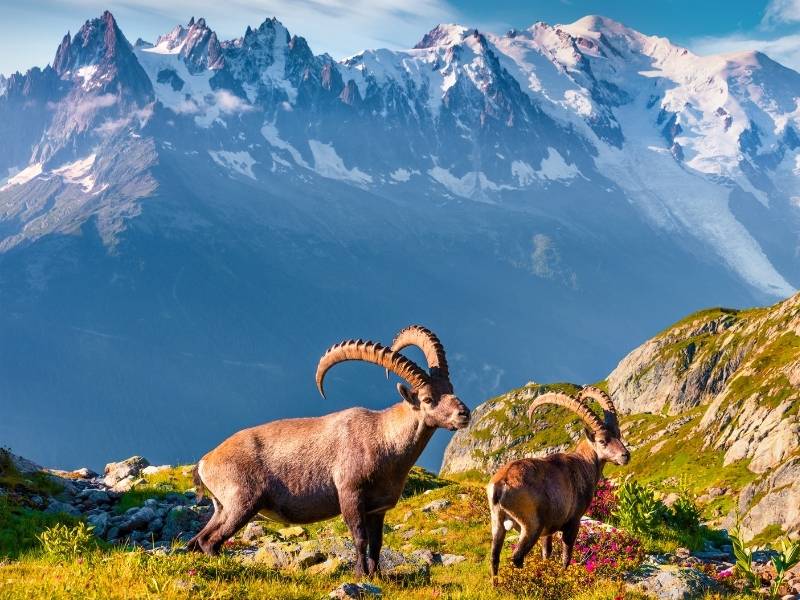
The scenery and adventure aren’t the only things that make Chamonix worth visiting. Another reason to visit Chamonix is the wildlife in the Alps. The animals in the alpine wilderness are some of the most magical you can find, at least in my opinion.
My judgment is largely influenced by the animals in my favorite fantasy movies, namely The Hobbit and The Lord of The Rings. If you’ve seen these films, you’ll be familiar with Thranduil’s elk, which led me to believe that the animals in the Alps are magical! While there are no elks in Chamonix as they are primarily found in North America, Chamonix is home to deer, which are quite similar to elks. In fact, an elk is a type of deer.
In addition to deer, you’ll also find Alpine ibex, chamois, marmots, and more in Chamonix. You might even encounter wildlife while hiking to Lac Blanc and Lacs des Chéserys! Like these lakes, these animals are the gems you’ll discover while hiking in Chamonix.
It’s important to note that Lac Blanc and Lacs des Chéserys are part of the Aiguilles Rouges National Nature Reserve. That’s why you can expect to see wildlife in these areas.
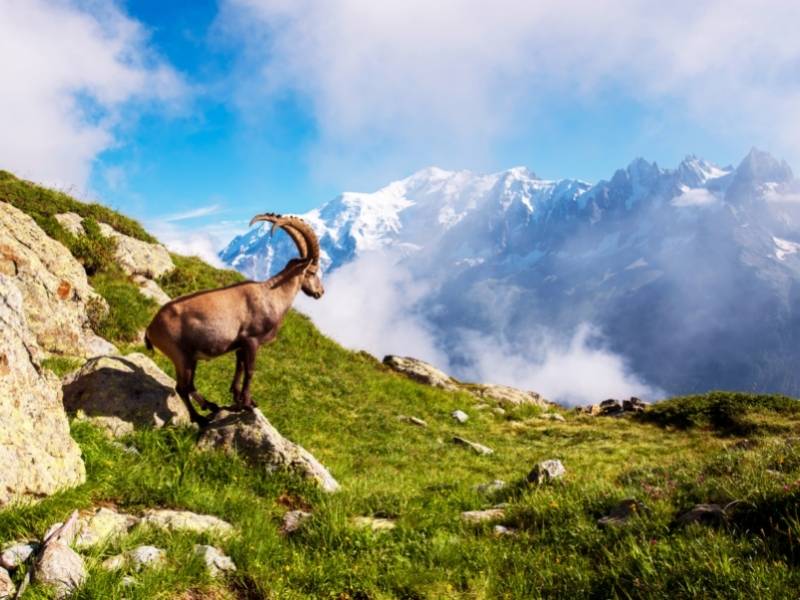
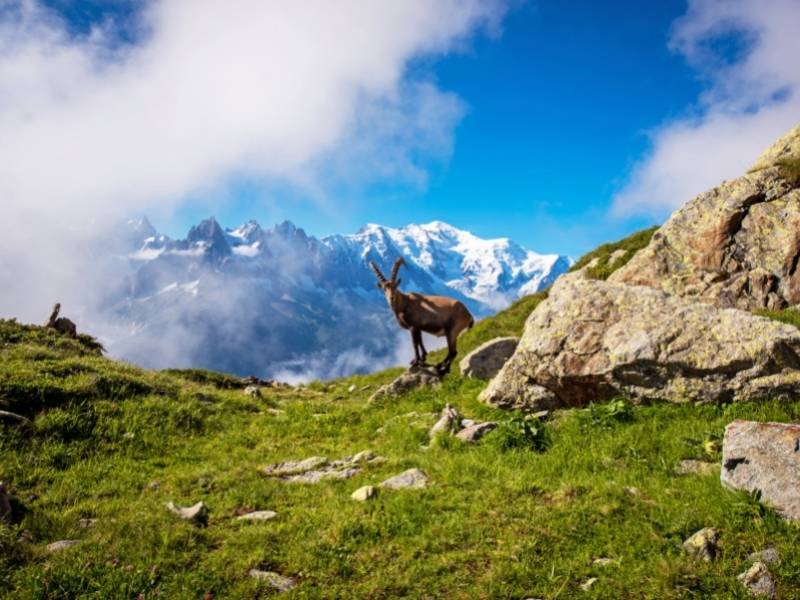
At times, you might see these animals grazing or simply gazing at you. If you enjoy photography, this could be an opportunity to practice wildlife photography. Imagine yourself as a stealthy NatGeo Wild photographer!
If you’re an animal lover and don’t want to miss out on seeing these graceful alpine creatures, consider booking your visit to Merlet Wildlife Park now! Here’s the link to the Park Merlet reservation page.
Merlet Wildlife Park is home to many animals found in the mountains, including various kinds of deer, marmots, ibex, and chamois. Surprisingly, there are also llamas in the park! Their presence gives the impression of having visited the mountains of South America.
The unique aspect of Merlet Wildlife Park is that the alpine animals aren’t caged. They roam freely in the woods and meadows, and you can easily spot them on the park’s mini hiking trail.
Merlet Wildlife Park is perched 1500 meters (4921 feet) above sea level in the Aiguilles Rouges mountain range. From certain vantage points, you can see and photograph these majestic animals with the Mont Blanc massif as a backdrop.
You should visit the Merlet Wildlife Park’s website to prepare for your visit. If you’re interested, it’s advisable to book as early as possible. Reservation slots tend to fill up quickly, especially during the summer.
7. Overall Wellbeing Improvement in Chamonix — The Magic of the Mountains

Mountainous regions like Chamonix are havens for fun, adventure, and relaxation. They offer numerous awe-inspiring attractions and fantastic activities, all in one destination.
That’s why a trip to Chamonix would not be a waste of time or money. You’ll undoubtedly be filled with awe time and again in Chamonix. Combine this with adrenaline-pumping adventures, and your stress, worries, and anxieties will surely be wiped from your mind!
How do I know that mountains can have this effect? I’ve experienced it myself. I believe nature possesses a magical power that can heal what’s hurting inside us.
I want to share that my travel experiences in the mountains are what gave me the strength to pursue my passion. Hiking in the mountains made me realize that if I can conquer these physical mountains, I can also conquer the metaphorical mountains within me and achieve my dreams.
That said, mountains can provide holistic benefits and improvements. Not to mention the fresh air that’s so good for our lungs! Those, I believe, are the best reasons why everyone should visit places like Chamonix. However, it’s important to remember that the beautiful scenery and soothing tranquility in the mountains merely enable us to acquire these holistic benefits from traveling to such places.
For you to have it is simple:
spend more time in the mountains. Go hiking and allow yourself time to commune with nature. Let the peaceful surroundings resonate with your mind. By cultivating a peaceful mind, we can look within ourselves, engage in soul-searching, release internal tensions, and introspect. After a day or two, or even more, of doing this, I bet you’ll feel healed and rejuvenated.
Also, you don’t need to venture to extremely secluded locations in Chamonix to have a life-changing trip. As long as you can find peace, that will be enough. Some visitors to Chamonix hire instructors to accompany them on mountain meditative trips. In this regard, Intuition Montagne can assist. You can learn about Intuition Montagne from their website.
Additionally, you can find mountain meditation groups or workshops in Chamonix that offer Yoga classes. They can teach you various disciplines and techniques on how to heal, attain mindfulness, and so on. Here are a few that I discovered:
Note. I do not endorse or promote specific businesses in this post. I mention them only for the awareness of my readers.
8. Chamonix’s Bucket List Attractions — Don’t Miss Them!

I believe that most, if not all, of us have travel bucket lists. These lists contain a number of experiences or destinations we want to enjoy or visit in our lifetime. Fulfilling these bucket lists is a way for us to say that we have truly lived our lives before our final moments.
If you’ve finished creating your bucket list and haven’t included Chamonix, I think you might have overlooked something! Why do I say this? Because there are exceptional experiences to be had here, and they are a compelling reason to visit Chamonix. I’ve already mentioned a few of these experiences earlier in this post. The first one that comes to mind is Aiguille du Midi and its cable car.
Did you know that Aiguille du Midi boasts one of the highest cable car systems in the world?
For 20 years after its construction in 1955, Aiguille du Midi held the title of the highest cable car in Europe. However, it was relegated to second place as Europe’s highest cable car after the Klein Matterhorn aerial tramway in Zermatt, Switzerland, was built in 1976. Despite this, it still holds the title of the “world’s cable car with the highest vertical ascent.”
The Aiguille du Midi cable car ascends a total of 2754 meters (9035 feet), starting from the Chamonix village at an elevation of 1036 meters (3398 feet) and ending at the peak of Aiguille du Midi at 3,790 meters (12434 feet). You’ll soar from the ground, through the clouds, and above!
During the cable car ride, you’ll pass through a dense forest, see glaciers, and have an overview of Chamonix village. And that’s just the beginning of the fun! As mentioned earlier, breathtaking views of the Mont Blanc massif await you at the top—a sight you definitely shouldn’t miss!
In my view, the “Step Into The Void” at Aiguille du Midi is an experience not to be missed. Here, visitors step into a glass box. Upon entering, one is treated to a sweeping panorama of the Mont Blanc massif, complete with the thrilling sight of the 1000-meter (3280 feet) drop beneath.

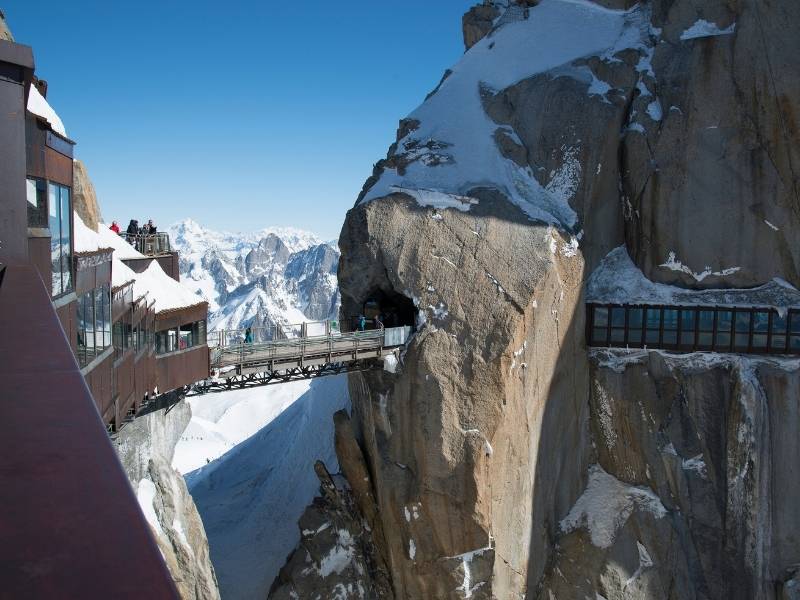
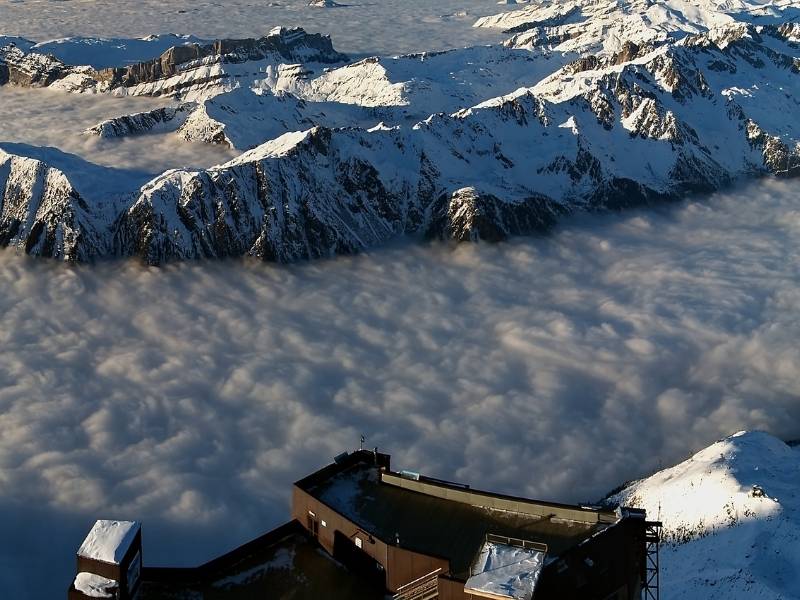
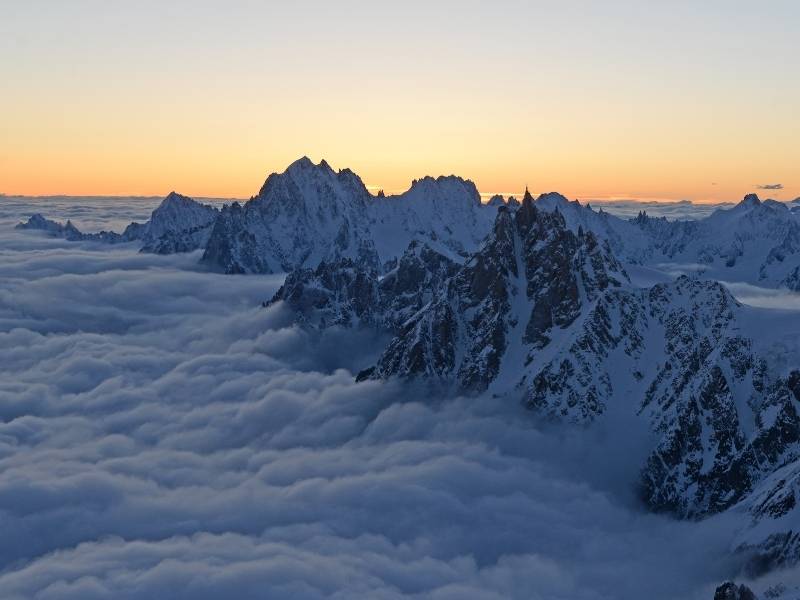
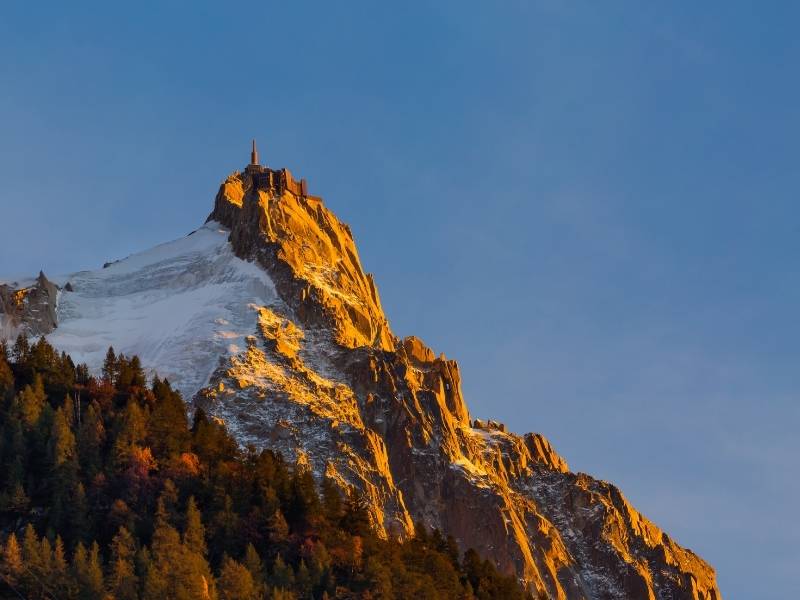
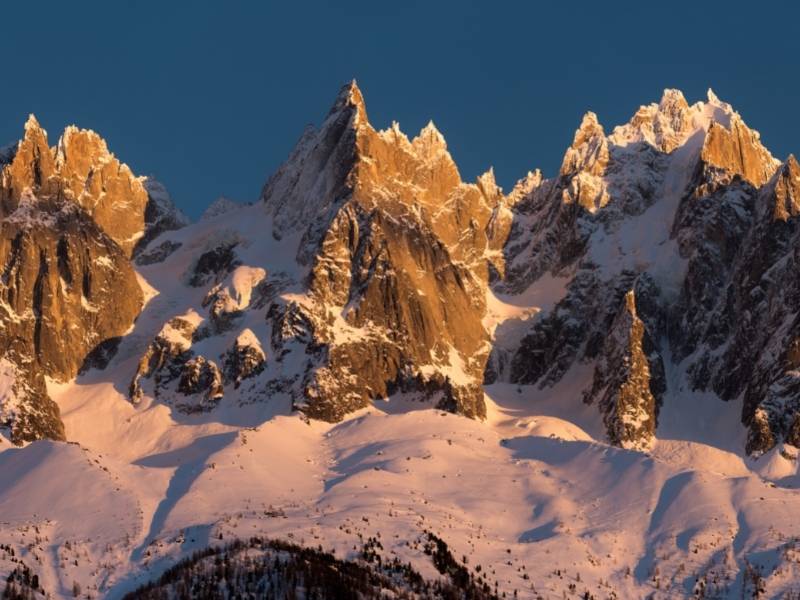
Other bucket list activities in Chamonix were discussed previously. But here’s a recap:
- Watch the sunset and sunrise at Lac Blanc and observe the peaks turn orange and red during the golden hour.
- Visit the Ice Cave in Mer de Glace. There are only a few places in the world where you can have this experience!
- Experience alpine animal encounters at Merlet Wildlife Park. There’s something truly graceful and magical about the horns of ibex and deer.
- Try tandem paragliding. It’s an unmissable experience. Feeling like you’re flying, having a bird’s eye view of Chamonix and its spectacular snow-capped mountains is genuinely unforgettable fun!
- Attend or participate in a festival held on a mountain in Chamonix. We’ll discuss these in more detail next. Stay tuned.
9. Fun Festivals & Events in Chamonix — For a More Memorable Visit
I was deeply amused the first time I attended a festival outside our country, quite by accident. Witnessing how people celebrate their culture and passion, and connect with each other, makes you realize the beauty of being human. Chamonix hosts a few festivals every year that you can participate in. However, if you’re looking for fun, I think the Cosmo Jazz festival is the best one to try!
The Cosmo Jazz Festival is not just entertaining, but also unique. As such, it could be considered a compelling reason to visit Chamonix.
Essentially, Cosmo Jazz is a music festival held in Chamonix. It was conceived with the aim of “sharing an extraordinary human adventure with people of all backgrounds, discovering stunning landscapes and dizzying cosmic sounds in a friendly atmosphere.”
The festival features concerts in the village center of Chamonix and various mountain locations. That’s right, performances take place in scenic spots such as lakes and hiking trails! Artists are encouraged to play their instruments and perform wherever they feel inspired. Depending on the program developed by the organizers and performers, you might even catch a concert near a glacier!
Here’s how the official website of Cosmo Jazz describes how the visitors may experience Chamonix during the festival:
“The public will be pleasantly surprised: in a cable car cabin; or in a cosmic alpine place; by the melodies of a flute; a voice singing; the breath of a brass or Indian percussion, all in a place when they least expect it.”
If you plan to attend the Cosmojazz festival, you might want to consider staying overnight in Chamonix as there will be more music performances in the evening.
Starting at 5:00 pm, extraordinary artists begin performing in the center of Chamonix village. Couttet Park, the main event venue for the Cosmo Jazz Festival, is where most of the excitement takes place. It features a large covered stage surrounded by bars, shops, and merchandise tents for souvenirs.
The Cosmo Jazz festival takes place every summer during the last week of July. You’ll need to reserve your slot to join the event at Couttet Park (you can get your tickets here). However, you can attend the high-altitude concerts for free. If you’re interested in going to Chamonix for the Cosmo Jazz festival, you can check the event’s official website for practical information and more.
10. Chamonix is An All-Year Destination — Fun Throughout the Seasons
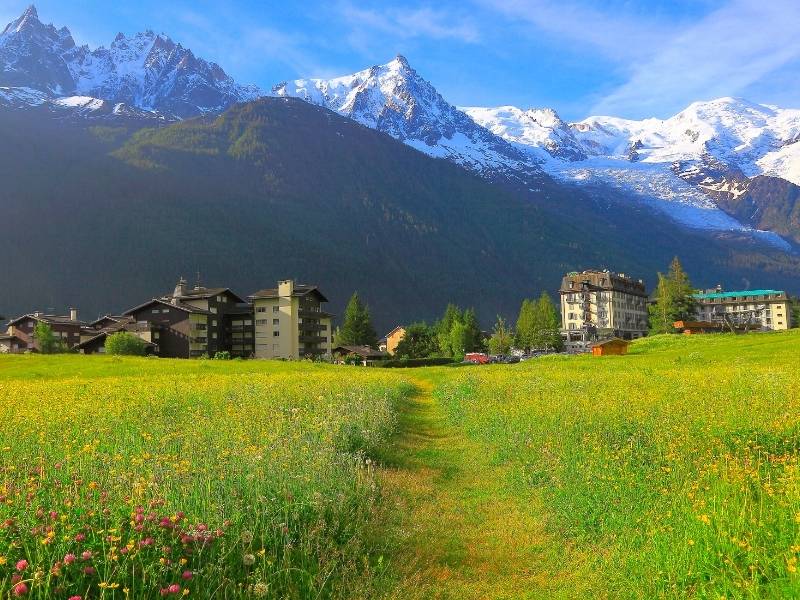
Summer is an ideal time to visit Chamonix, when there’s ample sunshine and less rainfall. We all prefer clear skies during our visit to Chamonix, as the scenery is enhanced by the sunlight, and it allows for more outdoor activities.
However, this doesn’t mean that Chamonix should only be visited in the summer. Chamonix is a stunning destination throughout the year. Depending on the type of beauty you wish to experience, Chamonix is always worth a visit, regardless of the season.
For instance, springtime in the alpine region is particularly charming. As the snow melts, it reveals expansive green meadows and plants, adorned with blooming wildflowers that are sure to bring a smile to your face! The villages in the Chamonix valley are all decorated with flowers, making it the most enchanting season.
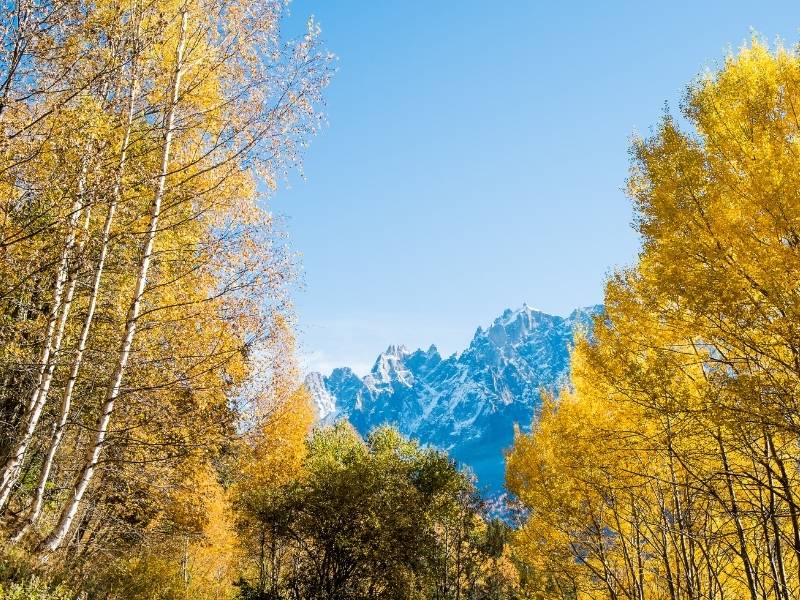
As autumn arrives, the mountains encircling Chamonix morph into a realm that seems almost mystical. The foliage shifts to shades of deep red and bright gold. A single hike can yield an abundance of picturesque moments!
The stark blue of the mountains set against the warm hues of the autumn leaves is a sight to behold. It feels as though I could spend the entire day meandering along the mountain paths, surrounded by such breathtaking views.

Winter? It’s a playground of snow! You have the option to ski, go dog sledding, or if you’re feeling bold, give ice climbing a shot. I personally believe that dog sledding is an experience you shouldn’t miss.

However, be aware that some amenities in Chamonix may not be operational during the off-peak seasons. Fear not! The top attractions, such as Aiguille du Midi, remain accessible throughout the year. Just remember to account for the maintenance period in November.
If inclement weather disrupts your visit to Chamonix during the off-peak season, there are plenty of indoor activities to keep you entertained. You can still enjoy yourself while waiting for the weather to improve. If it’s raining or snowing heavily and you’re itching for some excitement, why not try the laser game or escape game?
They’re great fun, especially if you’re with friends or family. If you’re on your own or simply looking to unwind, consider a trip to the spa! With a sauna, Nordic baths, treatments, and massage services on offer, you’ll be refreshed and ready for your next day’s adventure.
Where exactly is Chamonix?
Are you considering a trip to Chamonix now?
Chamonix is easy to spot on a map. It’s situated where the boundaries of France, Switzerland, and Italy converge. Specifically, it’s in the French region that is adjacent to both Italy and Switzerland. The central part of the village is perched at an altitude of 1,035 meters or 3,396 feet.
If you’re worried about getting altitude sickness, don’t be. It’s not common and usually only starts to occur at altitudes exceeding 2500 meters or 8000 feet.
I have used the available online travel resources to find all the cities near Chamonix and listed them in the table below. This table can be used as a reference to find an airport for reaching Chamonix or a destination to visit before or after Chamonix.
| City/Town | Country | Airport |
|---|---|---|
| Geneva | Switzerland | International |
| Montreux | Switzerland | None |
| Sion | Switzerland | Regional |
| Bern | Switzerland | International |
| Grenoble | France | International |
| Chambery | France | International |
| Lyon | France | International |
| Annecy | France | None |
| Turin | Italy | International |
| Milan | Italy | International |
| City/Town | Road Distance | Travel Time |
|---|---|---|
| Geneva | 82 kilometers | 1 hour |
| Montreux | 86 kilometers | 1 hour 13 minutes |
| Sion | 72 kilometers | 1 hour 5 minutes |
| Bern | 177 kilometers | 2 hours 6 minutes |
| Grenoble | 146 kilometers | 2 hours |
| Chambery | 146 kilometers | 1 hour 26 minutes |
| Lyon | 223 kilometers | 2 hours 16 minutes |
| Annecy | 101 kilometers | 1 hour 6 minutes |
| Turin | 169 kilometers | 2 hour |
| Milan | 240 kilometers | 2 hours 35 minutes |
| City/Town | Transportation | Travel Time |
|---|---|---|
| Geneva | direct bus | 1 hour 10 minutes |
| Montreux | 3 train rides | 2 hours 41 minutes |
| Sion | 3 train rides | 2 hours 23 minutes |
| Bern | 2 bus rides | 4 hours 29 minutes |
| Grenoble | direct bus | 2 hours 40 minutes |
| Chambery | direct bus | 2 hours 15 minutes |
| Lyon | direct bus | 2 hours 55 minutes |
| Annecy | direct bus | 1 hour 10 minutes |
| Turin | direct bus | 3 hours 5 minutes |
| Milan | direct bus | 3 hours 55 minutes |
I mentioned this information as we often consider the location of a destination (Chamonix, for this instance) if we’ll add it to our travel itinerary or not.
Here’s an interactive map to show you the exact location of Chamonix:
How to Go to Chamonix
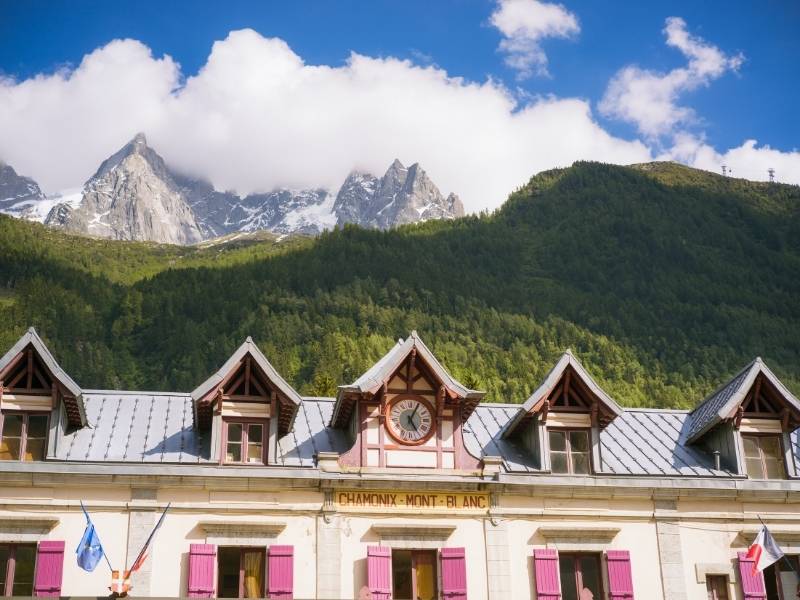
Based on the three tables comparing the cities and towns around Chamonix, it can be concluded that Geneva is the ideal city to start your journey to Chamonix, especially if you are coming from abroad.
Geneva boasts an international airport with numerous flight connections and is the closest city to Chamonix in terms of road distance. The travel time from Geneva to Chamonix is approximately an hour.
Furthermore, Geneva offers a variety of options for day trips to Chamonix. With the tour services available in Geneva, there’s no need to worry about planning every detail of your journey to Chamonix.
This is particularly useful if, for example, you don’t have time to plan things like booking entry passes, checking bus schedules, buying train tickets, or preparing your itinerary. Day trips and tours to Chamonix are also available from Annecy, Lyon, and Milan. A list of day trips and excursions to Chamonix can be found here.
Best Time to Visit Chamonix
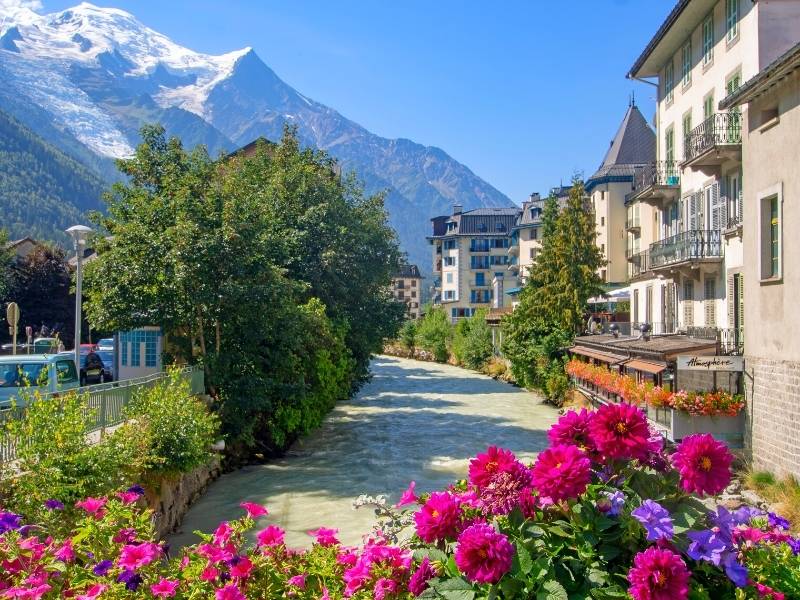
Although Chamonix is an all-year destination, the weather is definitely a factor to your overall trip to Chamonix. You must check the climate before you plan to go to Chamonix. I am not a weather expert, but I’ll try to give you suggestions based on the information from my resources:
- weather-atlas.com — All-year climate information about Chamonix
- seechamonix.com — Weather forecast and information about mountain climate, safety precautions, altitude effects, winds, and more.
As a general rule, if you’re not a skier, the best time to visit Chamonix is during the summer. This is when almost all hiking trails are open, alpine lakes are unfrozen, and the skies are clear. More importantly, Chamonix’s must-see attractions are open to everyone in the summer.
While summer begins in June, the most likely time to experience pleasant weather in Chamonix is from August to September, extending into early October. During these months, there are typically 14 to 20 days of sunshine, 8 to 13 days of rainfall, and less than 40% cloud cover.
The driest month in Chamonix is September, with only 15mm of precipitation. However, this doesn’t mean you shouldn’t visit Chamonix during other seasons. In fact, Chamonix is a ski resort. If you enjoy skiing, husky rides, ice-climbing, and more, you’ll find Chamonix worth visiting in the winter.
As far as I’m aware, Chamonix is a year-round destination. The best time to visit Chamonix depends on the activities you want to do and the scenery you want to see. We’ll discuss more about these later.
More Tips in Visiting Chamonix
The Alps are a unique destination that everyone should include in their bucket list. If you’ve chosen to add Chamonix to your list and plan to visit, I’ve provided links below to assist you.
For accommodations in Chamonix, you can use this link to view all available options. Here, hotels can be sorted based on price, star rating, amenities, and more. With the provided link, you can locate hotels on a map, which is particularly useful if you have a specific attraction in mind.
If you’re planning to explore Chamonix for just a day, here is a list of guided tours and various day trips. These resources can help eliminate the stress of planning and booking.
- If you are from Geneva, I recommend this day trip that offers a skip-the-line perk to the attractions in Chamonix. On this tour, you will go to Chamonix using a bus (fee included in the package).
- If you are from Geneva and you want to visit Chamonix with a mode of private transport, a private guide, and also a skip-the-line privilege, check this tour.
Finally, remember to download the Chamonix mobile application [Apple | Android] for convenient travel around the valley. It will assist you in finding the best dining spots, planning your itinerary, checking the status of high-altitude cable car stations, and more.
If you’d rather not use the app, there’s a list of brochures that can be incredibly useful for your visit to Chamonix. The link includes maps of hiking trails and highlights for each village in the Chamonix valley.
Where to Next After Chamonix?
When it comes to picturesque destinations in France, there’s a wealth of options. However, given Chamonix’s location in southeastern France, you might want to explore top spots in the southern and eastern parts of the country.
If historical and cultural exploration is your thing, cities like Annecy, Lyon, Avignon, Colmar, Strasbourg, Reims, and of course, Paris should be on your list.
- Annecy is closest to Chamonix and offers romantic vistas against a backdrop of mountains and lakes.
- Lyon is globally renowned as a gastronomic hub but has much more to offer.
- Avignon stands out with its unique history as the 14th-century residence of popes.
- For a magical experience straight out of a storybook, visit Colmar and Strasbourg with their vibrant half-timbered houses in medieval town centers.
- If you’re a wine lover, Reims in the heart of the Champagne region is a must-visit but remember it has more than just bubbly!
- And Paris? Its iconic landmarks, exquisite architecture and awe-inspiring artworks need no introduction.
If you have a penchant for less-traveled destinations and charming villages, consider visiting the top 10 most beautiful villages in Southern France. Chamonix is one of them, and the remaining nine are Moustiers-Sainte-Marie, Aigues-Mortes, Domme, Saint-Cirq-Lapopie, Rocamadour, Carcassonne, Gordes, Eze, and Saint-Paul-de-Vence.
For those seeking a delightful village nestled amidst stunning natural scenery akin to Chamonix, Moustiers-Sainte-Marie and Aigues-Mortes are worth considering. History enthusiasts and architecture aficionados should explore Domme, Saint-Cirq-Lapopie, Rocamadour, and Carcassonne. If you’re drawn to villages that have retained their medieval charm and boast breathtaking locations, Gordes, Eze, and Saint-Paul-de-Vence should be on your itinerary.
Well, that’s all I have on Chamonix at the moment! I hope this post has been useful and has given you a glimpse into the wonderful experiences that lie in store for you at this beautiful part of France. Enjoy your upcoming travels!
Save it on Pinterest.

